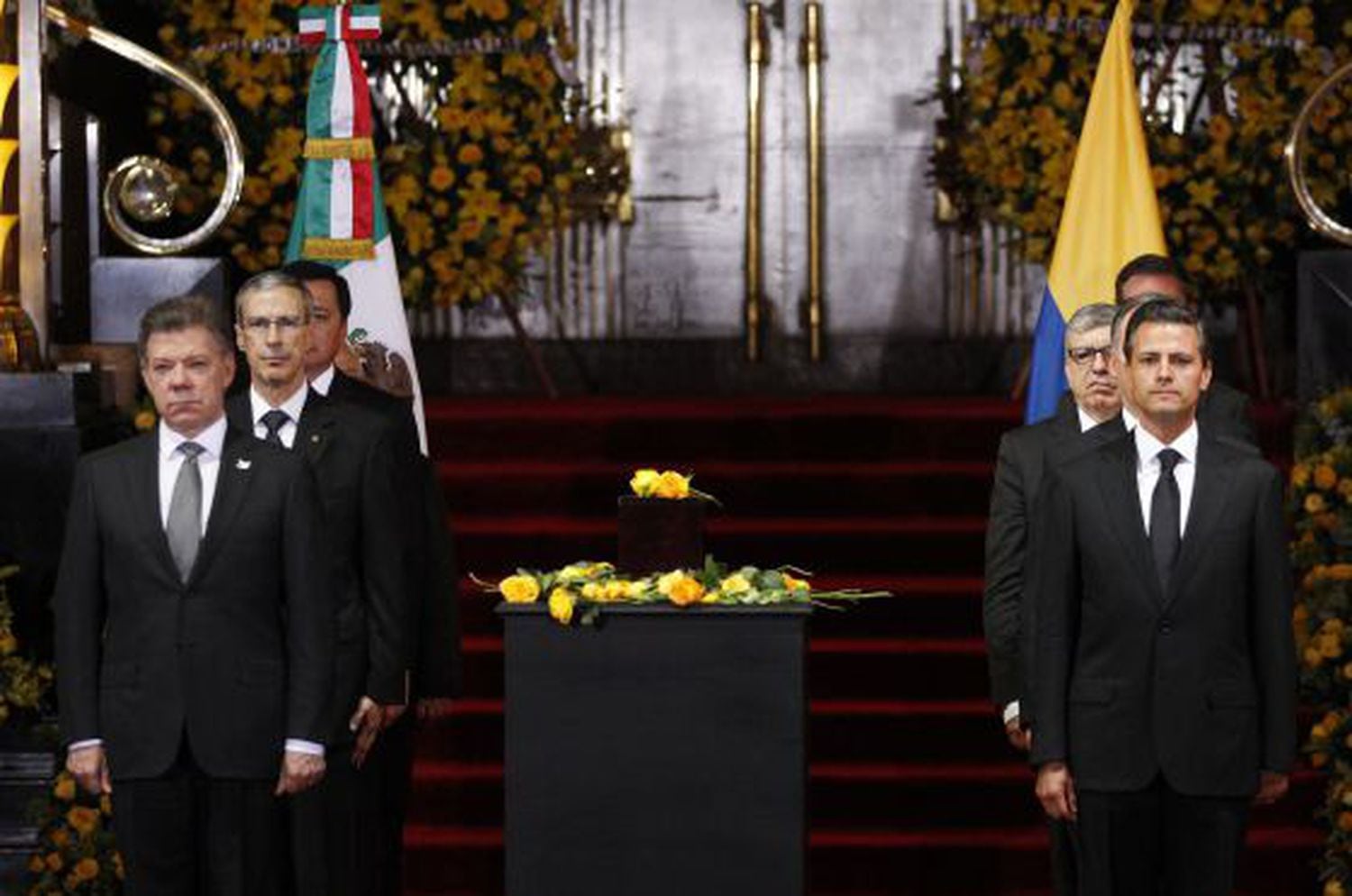 Colombia's President Juan Manuel Santos (l) and his Mexican counterpart Enrique Peña Nieto (r) stand next to the urn containing the ashes of late Colombian Nobel laureate Gabriel Garcia Marquez in Mexico City. EDGARD GARRIDO / REUTERS
Colombia's President Juan Manuel Santos (l) and his Mexican counterpart Enrique Peña Nieto (r) stand next to the urn containing the ashes of late Colombian Nobel laureate Gabriel Garcia Marquez in Mexico City. EDGARD GARRIDO / REUTERSThousands turn out to give “Gabo” a final farewell
Even in death, author Gabriel García Márquez was able to bring world leaders together
Juan Cruz / Juan Diego Quesada
Mexico City, 22 April 2014
Family members, friends and politicians bade a fond farewell to the man considered the most important Spanish-language author of the 20th century in Mexico City on Monday.
Mercedes Barcha, the widow of Gabriel García Márquez, who died on Thursday at age 87, arrived at the capital's Palace of Fine Arts with her husband’s ashes shortly after 4pm. The audience – all wearing yellow roses, his personal favorite – broke out into spontaneous applause as soon as she entered carrying the cherrywood urn. The ovation lasted for four minutes, a tribute to the affection held for Colombian-born literary genius.
A group of musicians began strumming a vallenato tune – Colombian Caribbean folk music that he was typically fond of – as people swayed and danced in their seats. At the entrance, about 10,000 fans and devotees who had waited for hours to say goodbye cheered: “Long live Gabo.”
Even in death, this universal Colombian, who made Mexico City his home for decades but never gave up his nationality, broke down barriers. In the Palace of Fine Arts he was awarded honors that had previously only been reserved for Mexico’s most illustrious children: Diego Rivera, Frida Kahlo, Cantinflas and María Félix all had their official funerals here.
Gabo, as he was known, also accomplished in death what he set out to do in life: bring heads of state together, especially from countries with differences. In this case, no major controversies exist between Mexico and Colombia – both are solid trading partners – but his funeral marked the first time that two sitting heads of state had come together for such a solemn ceremony at the Palace of Fine Arts.
“What a privilege it is to call him a compatriot,” said Colombian President Santos
Both arriving late – something that García Márquez would never have tolerated – Mexico’s Enrique Peña Nieto and Colombia’s Juan Manuel Santos stood momentarily next to the urn containing the ashes of the late Nobel Prize laureate. García Márquez had made Mexico City his home in the 1960s and it was here that he wrote his greatest work, One Hundred Years of Solitude, in the early part of that decade.
Flanking the author’s widow during the non-religious ceremony, the two presidents took their places.
“What a privilege it is to call him a compatriot,” Santos said, describing him as the “most Colombian of all Colombians.”
“May this person who gave us the most glory have eternal glory,” he said.
But it was Peña Nieto’s address that drew the most expectation. It is still fresh in many Mexicans’ minds how their president stumbled a few years back when he was asked by a reporter to list the last three books that had influenced his life. The interview occurred during the International Book Fair in Guadalajara at the height of the presidential campaign – Peña Nieto had trouble naming one.
This time the Mexican president did not slip up. In fact, his remarks were peppered with anecdotes. Calling the writer “the greatest Latin American novelist of all time,” he pointed out that García Márquez died on the same day as 17th-century writer Sister Juana Inés de la Cruz.
“García Márquez held the best conversations through his books,” noted one admirer
Gabriel García Márquez died on Holy Thursday April 17 at his home in Mexico City where he had been receiving palliative care. He was surrounded by his family.
Even though he died far from his birthplace, he never forgot Aracataca, Colombia. Besides Mexico, he also lived in exile in Barcelona and Paris and traveled the world with his wife, who was always by his side.
People began gathering outside the Palace of Fine Arts early Monday morning for the public viewing of the ashes. The entrance was flanked by two gigantic black and white posters of the Colombian author together with the dates: 1927-2014.
Liliana Aguilar, an engineering student, was one of the first to arrive. Visibly saddened by García Márquez’s death, she forgot her own grief for a moment to recall how the novelist was able to capture “that Latin American sadness” in his works.
Husband and wife Eleoní Rivera and Flor Cabrera also arrived early. In his honor, they both wore guayaberas –a formal shirt worn in the Spanish-speaking Caribbean that Gabo customarily donned. They recalled how they ran into García Márquez on January 1, 2009 in Havana during the 50th anniversary of the Cuban revolution. It was at the ballet and Rivera went up to greet Gabo who was surrounded by photographers and journalists. What did he tell him?
“Not much,” recalled Rivera, “but he held the best conversations through his books.”
The group Guatapurí de Valledupar broke the solemnity by adding a festive note with their vallenato numbers. The music even brought smiles to the faces of the grieving family. It is what Gabriel García Márquez would have wanted.


No comments:
Post a Comment